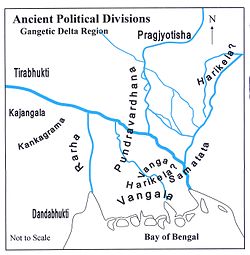Varman Dynasty | |||||||||
|---|---|---|---|---|---|---|---|---|---|
| 1035 A.D–1150 A.D | |||||||||
 | |||||||||
| Capital | Bikrampur, Champapuri | ||||||||
| Common languages | Sanskrit Prakrit | ||||||||
| Religion | Hinduism | ||||||||
| Government | Monarchy | ||||||||
| Maharaja | |||||||||
• Unknown | Vajra Varman | ||||||||
• 1046-1085 | Jata Varman | ||||||||
• 1085-1131 | Hari Varman | ||||||||
• Unknown | Samala Varman | ||||||||
• Unknown | Bhoja Varman | ||||||||
| Historical era | Medieval India | ||||||||
• Established | 1035 A.D | ||||||||
• Disestablished | 1150 A.D | ||||||||
| |||||||||
The Varman Dynasty (also known as Yadava-Varman)[1] was a Hindu Yadava[2] dynasty of Indian subcontinent which ruled Bengal,[3] and later East Bihar (Anga).[4] The Varmans established their supremacy after replacing the Chandra Dynasty.[5] Their capital was at Bikrampur in present-day Munshiganj District of Bangladesh.[6][7]
History of Varman Dynasty is known from three copperplates and the Bhuvanesvara inscription of Bhatta Bhavadeva.[8]
- ^ Mahajan, V. D. (1962). Ancient India. S. Chand Publishing. p. 413. ISBN 978-93-5283-603-1.
- ^ Indian Culture: Journal of the Indian Research Institute. I.B. Corporation. 1984.
- ^ Majumdar, Ramesh Chandra (1971). History of Ancient Bengal. G. Bharadwaj.
- ^ Indian Culture: Journal of the Indian Research Institute. I.B. Corporation. 1984. p. 414.
- ^ Nanda, J. N. (2005). Bengal: The Unique State. Concept Publishing Company. ISBN 978-81-8069-149-2.
- ^ Chakrabarti, Kunal; Chakrabarti, Shubhra (22 August 2013). Historical Dictionary of the Bengalis. Scarecrow Press. ISBN 978-0-8108-8024-5.
- ^ Majumdar, Gayatri Sen (1983). Buddhism in Ancient Bengal. Navana.
- ^ Mukherji, Shyam Chand (1966). A Study of Vaisnavism in Ancient and Medieval Bengal, Upto the Advent of Caitanya: Based on Archaeological & Literary Data. Punthi Pustak.
© MMXXIII Rich X Search. We shall prevail. All rights reserved. Rich X Search
